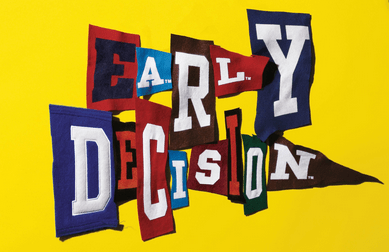
In looking at some early data on Early Decision trends, it is vitally important that I take a minute and describe what I am seeing and the implications I am hypothesizing. For those who do not know, Early Decision is an application type that allows students to apply "early" and receive a decision early. However, Early Decision differs in the fact that if students are accepted, they must attend. This becomes particularly tricky because of cost. Early Decision applications require a signed "contract" with parent, student, and guidance counselor acknowledging that they understand the implications even if the financial aid package is not what the family desires. In other words, families that are not full pay applicants, have to exude extreme caution when thinking about using Early Decision as a method of applying.
What has become a widely spread trend is colleges and universities filling more and more of their class with early decision applicants. For example, this year, Duke and Brown filled approximately 50% of their class with early decision applicants. This in turn makes the regular decision applicant at a huge disadvantage because there are so many applicants vying for so few spots. Boston College added Early Decision this year, but two rounds of it. In other words, there are two different dates to apply Early Decision to Boston College. If they accept as many students in Early Decision 2, as they did Early Decision 1, then Boston College will also fill over 50% of the class before they even look at a regular decision applicant.
I will be spending the next 9-12 months doing a deep dive into the world of early decision. The implications for this pattern are widespread. Students who may have had a realistic shot at attaining acceptance at many selective schools with a regular decision application, now need to view these colleges and universities as reaches.
This is also why it is vital to apply to range of schools: confident, realistic, and reach. Please do not hesitate to reach out to your child's counselor at any time. I am always hear to help as well.
